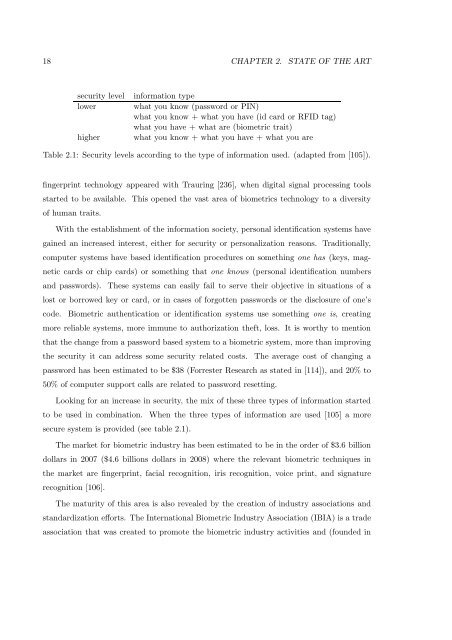Thesis - Instituto de Telecomunicações
Thesis - Instituto de Telecomunicações
Thesis - Instituto de Telecomunicações
You also want an ePaper? Increase the reach of your titles
YUMPU automatically turns print PDFs into web optimized ePapers that Google loves.
18 CHAPTER 2. STATE OF THE ARTsecurity levellowerhigherinformation typewhat you know (password or PIN)what you know + what you have (id card or RFID tag)what you have + what are (biometric trait)what you know + what you have + what you areTable 2.1: Security levels according to the type of information used. (adapted from [105]).fingerprint technology appeared with Trauring [236], when digital signal processing toolsstarted to be available. This opened the vast area of biometrics technology to a diversityof human traits.With the establishment of the information society, personal i<strong>de</strong>ntification systems havegained an increased interest, either for security or personalization reasons. Traditionally,computer systems have based i<strong>de</strong>ntification procedures on something one has (keys, magneticcards or chip cards) or something that one knows (personal i<strong>de</strong>ntification numbersand passwords). These systems can easily fail to serve their objective in situations of alost or borrowed key or card, or in cases of forgotten passwords or the disclosure of one’sco<strong>de</strong>. Biometric authentication or i<strong>de</strong>ntification systems use something one is, creatingmore reliable systems, more immune to authorization theft, loss. It is worthy to mentionthat the change from a password based system to a biometric system, more than improvingthe security it can address some security related costs. The average cost of changing apassword has been estimated to be $38 (Forrester Research as stated in [114]), and 20% to50% of computer support calls are related to password resetting.Looking for an increase in security, the mix of these three types of information startedto be used in combination. When the three types of information are used [105] a moresecure system is provi<strong>de</strong>d (see table 2.1).The market for biometric industry has been estimated to be in the or<strong>de</strong>r of $3.6 billiondollars in 2007 ($4.6 billions dollars in 2008) where the relevant biometric techniques inthe market are fingerprint, facial recognition, iris recognition, voice print, and signaturerecognition [106].The maturity of this area is also revealed by the creation of industry associations andstandardization efforts. The International Biometric Industry Association (IBIA) is a tra<strong>de</strong>association that was created to promote the biometric industry activities and (foun<strong>de</strong>d in
















